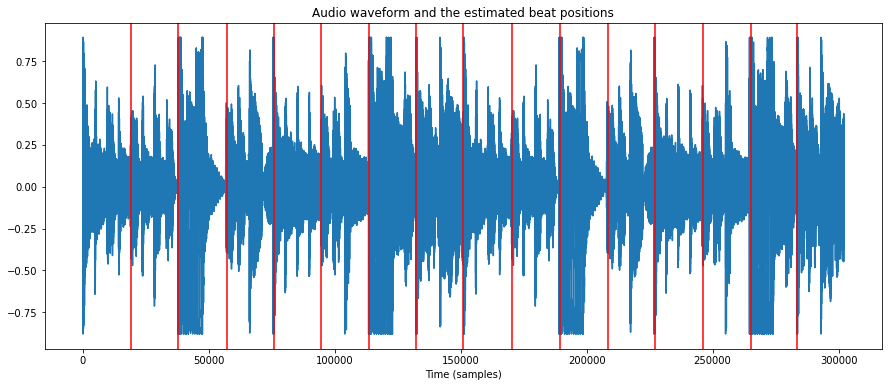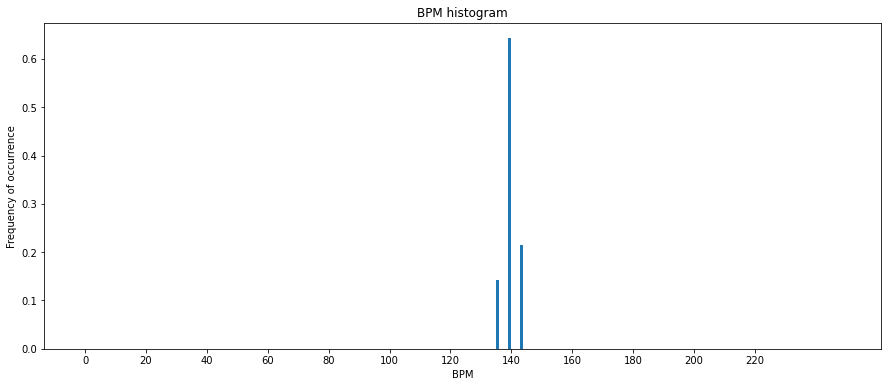Beat detection and BPM tempo estimation¶
In this tutorial, we will show how to perform automatic beat detection (beat tracking) and tempo (BPM) estimation using different algorithms in Essentia.
RhythmExtractor2013¶
We generally recommend using
RhythmExtractor2013
for beat and tempo estimation. This a wrapper algorithm providing two
approaches, slower and more accurate multifeature vs. faster
degara, using the auxiliary
BeatTrackerMultiFeature
and
BeatTrackerDegara
for beat position estimation, respectively.
The RhythmExtractor2013 algorithm outputs the estimated tempo (BPM),
time positions of each beat, and confidence of their detection (in the
case of using multifeature). In addition, it outputs the list of BPM
estimates and periods between consecutive beats throughout the entire
input audio signal. The algorithm relies on statistics gathered over the
whole music track, and therefore it is not suited for real-time
detection.
Similarly to our onset detection tutorial, to sonify the results, we mark the estimated beat positions in the audio, using AudioOnsetsMarker. To save the audio to a file, we use MonoWriter. Consult that tutorial for more details.
import essentia.standard as es
from tempfile import TemporaryDirectory
# Loading an audio file.
audio = es.MonoLoader(filename='../../../test/audio/recorded/dubstep.flac')()
# Compute beat positions and BPM.
rhythm_extractor = es.RhythmExtractor2013(method="multifeature")
bpm, beats, beats_confidence, _, beats_intervals = rhythm_extractor(audio)
print("BPM:", bpm)
print("Beat positions (sec.):", beats)
print("Beat estimation confidence:", beats_confidence)
# Mark beat positions in the audio and write it to a file.
# Use beeps instead of white noise to mark them, as it is more distinctive.
marker = es.AudioOnsetsMarker(onsets=beats, type='beep')
marked_audio = marker(audio)
# Write to an audio file in a temporary directory.
temp_dir = TemporaryDirectory()
es.MonoWriter(filename=temp_dir.name + '/dubstep_beats.flac')(marked_audio)
BPM: 139.98114013671875
Beat positions (sec.): [0.42956915 0.8591383 1.3003174 1.7182766 2.1478457 2.577415
2.9953742 3.4249432 3.8661225 4.2956915 4.7252607 5.15483
5.584399 6.013968 6.431927 ]
Beat estimation confidence: 3.9443612098693848
We can now listen to the resulting audio with the beats marked by beeps. We can also visualize beat estimations.
import IPython
IPython.display.Audio(temp_dir.name + '/dubstep_beats.flac')
from pylab import plot, show, figure, imshow
%matplotlib inline
import matplotlib.pyplot as plt
plt.rcParams['figure.figsize'] = (15, 6)
plot(audio)
for beat in beats:
plt.axvline(x=beat*44100, color='red')
plt.xlabel('Time (samples)')
plt.title("Audio waveform and the estimated beat positions")
show()

BPM histogram¶
The BPM value output by RhythmExtactor2013 is the average of all BPM estimates done for each interval between two consecutive beats. Alternatively, we can analyze the distribution of all those intervals using BpmHistogramDescriptors. This is especially useful for music with a varying tempo (which is not the case in our example).
peak1_bpm, peak1_weight, peak1_spread, peak2_bpm, peak2_weight, peak2_spread, histogram = \
es.BpmHistogramDescriptors()(beats_intervals)
print("Overall BPM (estimated before): %0.1f" % bpm)
print("First histogram peak: %0.1f bpm" % peak1_bpm)
print("Second histogram peak: %0.1f bpm" % peak2_bpm)
fig, ax = plt.subplots()
ax.bar(range(len(histogram)), histogram, width=1)
ax.set_xlabel('BPM')
ax.set_ylabel('Frequency of occurrence')
plt.title("BPM histogram")
ax.set_xticks([20 * x + 0.5 for x in range(int(len(histogram) / 20))])
ax.set_xticklabels([str(20 * x) for x in range(int(len(histogram) / 20))])
plt.show()
Overall BPM (estimated before): 140.0
First histogram peak: 140.0 bpm
Second histogram peak: 0.0 bpm

BPM estimation with PercivalBpmEstimator¶
PercivalBpmEstimator is another algorithm for tempo estimation.
# Loading an audio file.
audio = es.MonoLoader(filename='../../../test/audio/recorded/dubstep.flac')()
# Compute BPM.
bpm = es.PercivalBpmEstimator()(audio)
print("BPM:", bpm)
BPM: 140.14830017089844
BPM estimation for audio loops¶
The BPM detection algorithms we considered so far won’t necessarily produce the best estimation on short audio inputs, such as audio loops used in music production. Still, it is possible to apply some post-processing heuristics under the assumption that the analyzed audio loop is expected to be well-cut.
We have developed the LoopBpmEstimator algorithm specifically for the case of short audio loops. Based on PercivalBpmEstimator, it computes the likelihood of the correctness of BPM predictions using the duration of the audio loop as a reference.
# Our input audio is indeed a well-cut loop. Let's compute the BPM.
bpm = es.LoopBpmEstimator()(audio)
print("Loop BPM:", bpm)
Loop BPM: 140.0
BPM estimation with TempoCNN¶
Essentia supports inference with TensorFlow models for a variety of MIR
tasks, in particular tempo estimation, for which we provide the
TempoCNN models.
The TempoCNN algorithm outputs a global BPM estimation on the entire audio input as well as local estimations on short audio segments (patches) throughout the track. For local estimations, it provides their probabilities that can be used as a confidence measure.
To use this algorithm in Python, follow our instructions for using TensorFlow models.
To download the model:
!curl -SLO https://essentia.upf.edu/models/tempo/tempocnn/deeptemp-k16-3.pb
% Total % Received % Xferd Average Speed Time Time Time Current
Dload Upload Total Spent Left Speed
100 1289k 100 1289k 0 0 8829k 0 --:--:-- --:--:-- --:--:-- 8829k
import essentia.standard as es
sr = 11025
audio_11khz = es.MonoLoader(filename='../../../test/audio/recorded/techno_loop.wav', sampleRate=sr)()
global_bpm, local_bpm, local_probs = es.TempoCNN(graphFilename='deeptemp-k16-3.pb')(audio_11khz)
print('song BPM: {}'.format(global_bpm))
song BPM: 125.0
We can plot a slice of the waveform on top of a grid with the estimated tempo to get visual verification
import numpy as np
duration = 5 # seconds
audio_slice = audio_11khz[:sr * duration]
plt.plot(audio_slice)
markers = np.arange(0, len(audio_slice), sr / (global_bpm / 60))
for marker in markers:
plt.axvline(x=marker, color='red')
plt.title("Audio waveform on top of a tempo grid")
show()

TempoCNN operates on audio slices of 12 seconds with an overlap of 6
seconds by default. Additionally, the algorithm outputs the local
estimations along with their probabilities. The global value is computed
by majority voting by default. However, this method is only recommended
when a constant tempo can be assumed.
print('local BPM: {}'.format(local_bpm))
print('local probabilities: {}'.format(local_probs))
local BPM: [125. 125. 125. 125.]
local probabilities: [0.9679363 0.9600502 0.9681525 0.9627014]